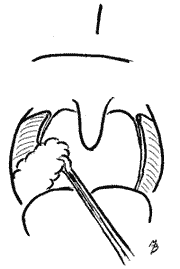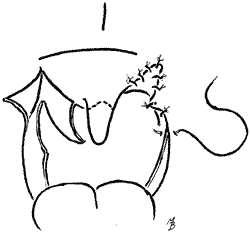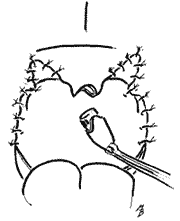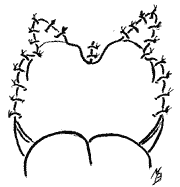INTRODUCTIONOtorhinolaryngologists have played an increasingly important role in the treatment of snoring and sleep-related respiratory disorders. Obstructive sleep apnea syndrome is the most serious manifestation of these disorders, but increased upper airways resistance may be present in sleep respiratory disorders, which are not associated with apnea¹¹. The term upper airway resistance syndrome was employed in this kind of situation. Night respiratory disorders are associated with excessive day drowsiness and worsening of patients' quality of life.
Uvulopalatopharyngoplasty (UPPP), introduced in 1964 5, is still the most common surgical procedure employed in cases of obstructive sleep apnea and socially disturbing snoring. The surgery proved to be extremely successful for habitual snoring and effective for carefully selective sleep apnea syndrome cases8. Due to satisfactory results and low morbidity, the technique was quickly multiply and widely used. However, in some occasions there are significant complications and even catastrophic consequences.
Among late complications that may derive from UPPP, the most frequent one is laryngeal discomfort, which has been associated with absence of uvula. Other less frequently but extremely feared complications are chronic velopharyngeal incompetence and nasal-pharyngeal stenosis. They are difficult to correct and prevention should be stressed.
In order to reduce the risk of such complications and develop a more predictable healing process, we added a modification to the traditional technique of UPPP. We carried out a zetaplasty on each side of the soft palate and subtotal uvulectomy. The aim was to expand the nasopharynx passage with minimal resection of tissue and to maintain the shape of the soft palate.
MATERIAL AND METHODNineteen patients underwent zetapalatopharyngoplasty (ZPPP) between November 1998 and June 2000, to treat snoring associated or not with night apnea. They were all adults and 11 were male and 8 were female patients.
In 11 patients, other surgical procedure was conducted together with ZPPP. Septoplasty was the most commonly associated procedure, and it was performed in 10 patients. Turbinectomy, together with septoplasty and ZPPP, was performed in 2 patients. Bilateral endoscopic frontomaxilloethmoidectomy associated with septoplasty and ZPPP was conducted in one patient, and endoscopic dacryocystorhinostomy associated with septoplasty and ZPPP was also performed in one patient. One patient was submitted to resection of submandibular gland tumor at the same surgical time of ZPPP.

Figure 1. Bilateral tonsillectomy preserving as much as possible the mucosa from, anterior and posterior pillars.
Surgical technique
The procedure is conducted under general anesthesia, and the head of the patient is extended and exposure is obtained with a mouth opener. We started with bilateral tonsillectomy, preserving mucosa from the anterior and posterior pillars as much as possible (Figure 1). Strict hemostasia of the bed of the tonsil is managed using a bipolar cautery. A Bunnell's suture is placed on the uvula. A lateral-superior incision is made on the soft palate, from the superior point of tonsil site. The triangular flap created, with a superiorlateral basis, is detached and put aside (Figure 2). A second incision is made on the middle part of the posterior tonsillar pillar and directed upwards and medially. The generated triangular flap with superior-medial basis is detached (Figure 3). The same procedures are repeated on the other side. The tip of the flap with a superior-medial basis is pulled and sutured on the superior extremity of the soft palate incision. The tip of the flap with superior-lateral basis is pulled and sutured on the superior extremity of the incision made on the posterior tonsillar pillar. Intermediate sutures were also made, putting together the flaps and concluding zetaplasty (Figure 4). The anterior pillar is sutured to the posterior one, leaving only a cruent area on the inferior portion of tonsil site. Sutures are similarly made on the other side. Subtotal uvulectomy is performed, resecting more muscle tissue than mucosa (Figure 5): Uvula incision is closed longitudinally, recreating a neo-uvula (Figure 6).

Figure 2. Lateral-posterior incision of the soft palate, from the superior point of tonsillar site. The generated triangular flap, with superior-lateral basis; is detached and put aside.
The use of analgesic, especially dipyrone, starts preoperatively and is maintained for 5 days at regular doses. Antibiotic prophylaxis with clyndamycin is started preoperatively and maintained for 24 hours. If there are no clinical contraindications, such as diabetes or arterial hypertension, corticoids are administered immediately after the surgery and maintained for 4 days. Post-operatively, the patient is told to gargle with a tablet of acetyl salicylic acid dissolved in a glass of water. Hospital discharge depends on how well the patient can swallow liquids orally to maintain appropriate hydration.
RESULTSAll patients were discharged from hospital the day following the surgery. The main post-op complaint was odynophagia, that tends to worsen until the third day, and from then on, it is reduced and disappears between the 7th and 10th post-op day. In some cases, patients needed opioids to control pain. One patient had late bleeding, requiring hemostasia under local anesthesia.

Figure 3. Second incision made on the middle part of the posterior tonsillar pillar, directed upwards and medially. The generated triangular flap, with superior-medial basis, is detached.

Figure 4. Sutures are made, putting together both flaps and concluding the zetaplasty.

Figure 5. Subtotal uvulectomy, resecting more in muscle tissue than mucosa.

Figure 6. Incision of uvula is closed longitudinally, recreating a neo-uvula.
After follow-up that varied from 1 to 18 months, we did not have any cases of nasopharyngeal stenosis or velopharyngeal incompetence. All patients showed improvement of symptoms and revision surgeries were not necessary.
DISCUSSIONExcessive day drowsiness and snore are important characteristics of sleep-related respiratory disorders. The physiopathologic spectrum of these disorders ranges from primary snore to more serious manifestations, such as sleep apnea syndrome. The increase in upper airway resistance is present even in patients with sleep respiratory disorders without apnea. Sleep disorders and day drowsiness are corrected when the intrathoracic pressure is brought back to normal levels¹¹.
Treatment is mainly mechanical or surgical, but not clinical with medication¹². All patients should be advised to lose weigh, avoid alcohol and sedatives, and to sleep on their sides16. Continuous positive air pressure administered with a nasal mask is a very successful treatment but it is not accepted nor tolerated by all patients. Dental devices may also be employed, but there are problems of adaptation.
In the last decade, many surgical innovations for the treatment of night respiratory disorders have been described16. Ambulatory techniques, such as laser-assisted uvulopalatoplasty (LAUP)7 and more aggressive procedures created to deal with obstructions at the level of hypopharynx and basis of the tongue were developed and have proven to be of value13,14,15,6, despite the limitations17. Individualized indication is recommended, depending on severity and level of airway obstruction16,13.
Despite the surge of these new techniques, since the day when uvulopalatopharyngoplasty (UPPP) was introduced to treat snore and obstructive sleep apnea3,18, the procedure has been the most widely used surgery to manage these cases9. The surgery is technically simple and it improves dramatically the quality of life of patients who have disabling snore and sleep apnea9.
For unselected patients, the reports of success of UPPP are more inconsistent, ranging from 0 to 90%16. Unsatisfactory results suggest the presence of narrowing of other regions, beside the palate, contributing to the obstructive process¹° ¹. Another possibility is the persistence of the obstruction at the level of the palate. Modifications to UPPP and transpalatal advancement pharyngoplasty have been considered to reduce the level of failures.
The procedure is also associated with risks and complications of variable severity. Although most post-op sequelae are mild, causing slight discomfort to the patient, there may also be significant complications³. The absence of uvula may be related to symptoms of post-op pharyngeal discomfort and speech disorders8. The main manifestation of velopharyngeal incompetence is nasal regurgitation and it is related with aggressive resection of the palate, especially on the middle line. Nasopharyngeal stenosis is a feared complication, because it causes important dysfunction and it is extremely difficult to be corrected4. It is also associated with excessive resection of rnucosa, especially of the posterior pillar².
Zetaplasty is a technical artifact frequently used in skin surgery to prevent and correct fibrosis and scarring retractions. Applying the same concept for palate surgery, we modified the UPPP in order to provide the maximum opening of the airway with minimal tissue resection. Therefore, we reduced the risks of having the most feared complications, such as velopharyngeal incompetence and nasopharyngeal stenosis, and at the same time we maximized functional results. The shape of the resulting palate is more natural, avoiding high palate and creating a neo-uvula. Similarly to all new surgical techniques, we have to wait for long term results to make sure that we have reached the desired objectives.
CONCLUSIONZetapalatopharyngoplasty is the natural association of two well-established procedures - uvulopalatopharyngoplasty and zetaplasty. It provides a more predictable healing process and simultaneously maximizes functional results and minimizes the risk of complications. The results of our experience have been very promising and it is our preferred method for the treatment of sleep respiratory disorders with obstructions at the level of palate.
REFERENCES 1. DONDAR, A. at al. - Lingual tonsil hypertrophy producing obstructive sleep apnea. Laryngoscope, 106: 1167-1169, 1996.
2. FAIRBANKS, D. N. F. - Uvulopalatopharyngoplasty complications and avoidance strategies. Otolaryngol. Head Neck Surg., 102: 239-245, 1990.
3. FUJITA, S. at al. - Surgical correction of anatomic abnormalities in obstructive sleep apnea syndrome: uvulopalatopharyngoplasty. Otolaryngol. head Neck Surg., 89: 923-934, 1981.
4. GHORAYEB, B. Y. - Cicatricial velopharyngeal stenosis. Arch. Otolaryngol. Head Neck Surg., 114: 192-194, 1988.
5. IKEMATSU, T. - Study of snoring, fourth report: therapy. J. Jap. Otorhinolaryngol., 64: 434-435, 1964.
6. JOHNSON, N. T. at al. - Uvulopalatopharyngoplasty and inferior sagittal mandibular osteotomy with genioglossus advancement for treatment of obstructive sleep apnea. Chest, 105 (1): 278-284, 1994.
7. KAMAMI, Y. V. - Outpatient treatment of sleep apnea syndrome with CO², laser: laser assisted UPPP. Journal Otolaryngology, 23(6): 395-398, 1994.
8. KATSANTONNIS, G. P. - Limitations, pitfalls and risk management in uvulopalatopharyngoplasty, in: Fairbanks D N F, Snoring and Obstructive Sleep Apnea, second edition, New York, Raven Press Ltd., 1994.
9. LARSON, L. H. at al. - Four-year follow-up after uvulopalatopharyngoplasty in 50 unselected patients with obstructive sleep apnea syndrome. Laryngoscope, 104: 1362-1368, 1994
10. LAUNOIS, S. H. at al. - Site of pharyngeal narrowing predicts outcome of surgery of obstructive sleep apnea. Am. Rev. of Respir. Dis., 147: 182-189, 1993.
11. NEWMAN, J. P. At al. - Recognition and surgical management of the upper airway resistance syndrome. Laryngoscope, 106: 1089-1093, 1996.
12. PQIRRIER, R. - Les traitements du syndrome des apnees obstructives dus sommeil. Acta Oto-Rhino-Laryngologica Belg., 47: 277-289, 1993.
13. RILEY, R. W. at al. - Obstructive sleep apnea syndrome: a review of 306 consecutively treated surgical patients. Otolaryngology Head Neck Surg., 108(2): 117-125, 1993.
14. RILEY, R. W. at al. - Maxillofacial surgery and nasal CPAP: A comparison of treatment for obstructive sleep apnea syndrome. Chest, 98 (6): 1421-1425, 1990.
15. RILEY, R. W. at al. - Obstructive sleep apnea and the hyoid: a revised surgical procedure. Otolaryngol. Head Neck Surg., 111 (6): 717-721, 1994.
16. UTLEY, D. S. at al. - A cost-effective and rational surgical approach to patients with snoring, upper airway resistance syndrome, or obstructive sleep apnea syndrome. Laryngoscope, 107: 726-734, 1997.
17. WALKER, R. P. at al. - Laser-assisted uvulopalatoplasty: postoperative complications. Laryngoscope, 106: 834-838, 1996.
18. WOODSON, B. T. - Retropalatal airway characteristics in uvulopalatopharyngoplasty compared with transpalatal advancement pharyngoplasty. Laryngoscope, 107: 735-740, 1997.
* Assistant Physician of the Otorhinolaryngology and Head and Neck Surgery Clinic at Hospital Felício Rocho and of the Service of Otorhinolaryngology at Hospital Governador Israel Pinheiro - IPSEMG, Belo Horizonte /MG.
** Resident Physician of the Service of Otorhinolaryngology at Hospital Governador Israel Pinheiro - IPSEMG, Belo Horizonte /MG.
*** Resident Physician of the Clinic of Otorhinolaryngology and Head and Neck Surgery at Hospital Felício Rocho, Belo Horizonte /MG.
Study presented at 35° Congresso Brasileiro de Otorrinolaringologia, which received a special citation.
This study received editorial support of Centro de Apoio à Ciência - CAC / Felicoop - Banco Bandeirantes.
Address for correspondence: Avenida do Contorno, 9215 - Sala 802 - 30110-130 Belo Horizonte /MG - Tel: (55 31) 291-8288 - Fax: (55 31) 337-5398.
Article submitted on August 15, 2000. Article accepted on October 20, 2000.


